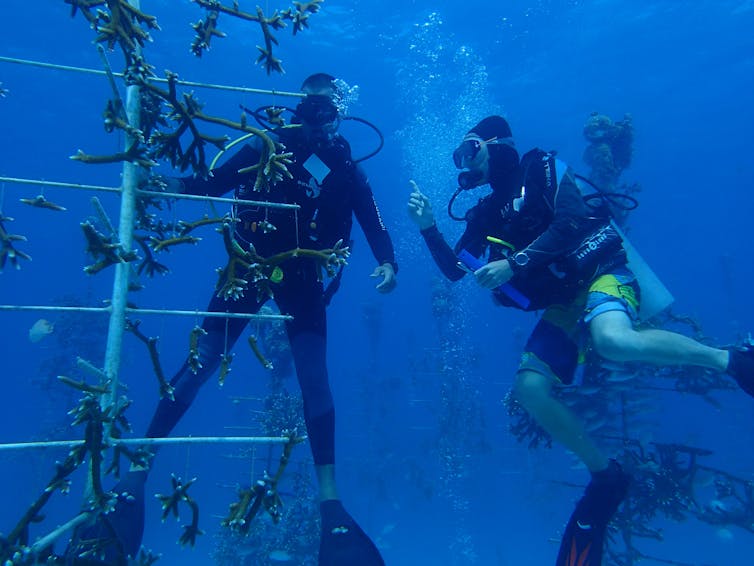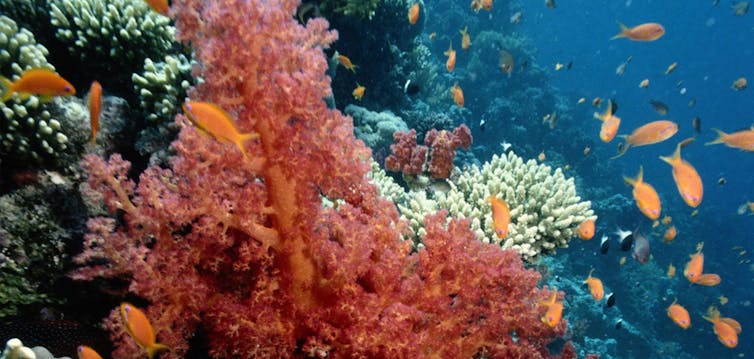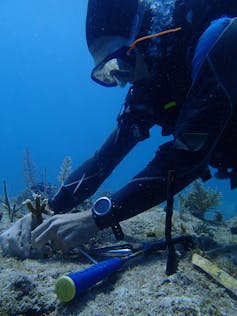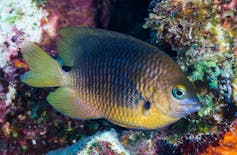Coral reefs are in crisis – but scientists are finding effective ways to restore them
- Written by Deron Burkepile, Associate Professor of Ecology, University of California, Santa Barbara
These are bleak times for coral reefs. Warming ocean waters[1], disease outbreaks[2], pollution[3], sedimentation[4], careless scuba divers[5], destructive fishing practices[6], and a host of other global and local stressors are decimating coral populations at unprecedented rates.
If there is any silver lining to these events, it may be that many of the disturbances killing corals are acute: They occur just for a short period of time and then disappear, potentially allowing corals to recover before the next disturbance. But as stressors become more and more frequent, humans may have to help foster corals’ recovery.
Many organizations are working to combat coral loss by restoring corals to damaged reefs. But some approaches are more likely to be successful in restoring coral populations than others.
Making reef restoration faster and more efficient will require creative approaches. In a new study[7], we describe how to harness the power of key ecological processes, including predation, competition and nutrient cycling, to make coral restoration more successful.
Coral reef restoration in the Florida Keys.Underwater nurseries
Coral restoration has seen a meteoric rise in popularity in the past 15 years. By our count, more than 150 operations are growing nursery-raised corals and transplanting them to degraded reefs just in the Caribbean. They include nongovernmental organizations like the Coral Restoration Foundation[8] and The Nature Conservancy[9]; federal, state and local government agencies, such as the National Oceanic and Atmospheric Administration[10]; universities; and private companies, such as the Iberostar hotel chain.
Jointly, these organizations restore tens of thousands of corals to reefs every year. Early results are promising. Across the Caribbean large fractions of restored corals are typically surviving past the first 1-2 years of transplantation.
The process starts by collecting a few finger-sized fragments from wild corals and transferring them to coral “nurseries” located in clear water with ideal growing conditions. Some groups grow corals on giant PVC structures that look like coral Christmas trees. Others use cinder blocks, old reef rocks or wire stands.
Within a year the new corals are more than 10 times larger – about the size of a volleyball, at least for the fastest-growing species. At this point they can either be fragmented again to create more nursery broodstock or transplanted to a degraded reef site.
 Selecting corals to be outplanted for restoration from the Coral Restoration Foundation nursery in the Florida Keys.
Mark Ladd, CC BY-ND[11]
Selecting corals to be outplanted for restoration from the Coral Restoration Foundation nursery in the Florida Keys.
Mark Ladd, CC BY-ND[11]
It takes a village to restore a reef
A major goal of coral restoration is to revive populations of stony corals that provide structure and habitat for the rest of the coral reef community, including soft corals, urchins, lobsters and fish. However, as restoration efforts expand around the globe, it is becoming increasingly clear it is not enough just to outplant corals. Healthy coral reefs are diverse communities with many intricate relationships between species that live on and around them.
To begin filling this knowledge gap, we dug through the literature on coral restoration to get an idea of how others are restoring corals to degraded reefs. We found that most experiments have focused on the best ways to grow corals in nurseries or the number of transplanted corals that survive.
But just as it takes more than replanting trees to bring back a thriving forest, restoring coral reefs will require more than putting corals back onto reefs. Surprisingly, few studies to date have measured how coral restoration affects important members of coral reef communities, like fishes, urchins, and diverse types of coral.
 Healthy coral reefs are diverse, complex ecosystems.
NOAA[12]
Healthy coral reefs are diverse, complex ecosystems.
NOAA[12]
Grazers and guardians
It is well-known that herbivorous species – the grazers of the sea – are critical to healthy coral reefs[13]. Fishes and urchins eat seaweeds that otherwise compete with corals for key resources like space and light. Seaweeds can also transmit diseases to corals and can quickly overtake a reef after some of its corals die off if herbivores are not present.
In our study, we propose that coral restoration efforts can benefit from concentrating coral outplants in areas where many grazers are present, such as near existing urchin populations or reefs where herbivorous fish are abundant. By doing so, corals are more likely to survive and grow quickly, and can begin to attract fish, which in turn will result in more grazing.
Fish also help corals grow by excreting nitrogen, an important nutrient for the symbiotic algae that live inside corals. This allows the algae to give more energy back to corals and make them grow faster. Planting coral at restoration sites in dense aggregations may help attract more fishes, which will fertilize the corals, help them grow and attract more fish.
 Mark Ladd outplanting an experimental colony of staghorn coral.
Mark Ladd, CC BY-ND[14]
Mark Ladd outplanting an experimental colony of staghorn coral.
Mark Ladd, CC BY-ND[14]
However, planting corals too densely can hasten disease transmission and competition between them – factors that can drastically impede the success of restoration. Finding the sweet spot, where corals are grouped densely enough to promote growth and attract fish but not so densely that they spread diseases and complete with each other, should be incorporated into restoration design[15].
Some members of coral reef communities have outsized influence on reef dynamics. Damselfishes are especially important. These small fishes have big attitudes: They fiercely protect their territories, where they garden algae to eat, from all other fishes, no matter how large. But these “Chihuahuas of the sea” can either help or hinder coral restoration.
In the Caribbean Sea, damselfishes often create their algal gardens by killing coral tissue. One of their favorite targets is staghorn coral (Acropora cervicornis), which is the most commonly used coral in restoration. This means that reefs with lots of damselfishes may be poor sites for restoration. Other reefs with many fish species that prey on damselfishes, such as small groupers, may be better choices.
 Small but fierce: Damselfish aggressively protect their reef territories.
zsispeo, CC BY-NC-SA[16][17]
Small but fierce: Damselfish aggressively protect their reef territories.
zsispeo, CC BY-NC-SA[16][17]
But on Pacific coral reefs, damselfish protect the corals in their gardens from large coral-eating fishes, such as pufferfishes and parrotfishes. So in the Pacific, damselfish gardens could function as restoration hotpots where outplanted corals can thrive and become established, thanks to their fierce fishy bodyguards.
Repopulating reefs
There are many more processes that restoration practitioners can harness to help facilitate repopulating reefs with corals. The future of coral restoration lies in combining experience in growing corals for transplantation with accumulated ecological knowledge about how reefs function. Until now, those two camps generally have operated in separate spaces. With corals in crisis worldwide, it is time to bring them together.
References
- ^ Warming ocean waters (dx.doi.org)
- ^ disease outbreaks (dx.doi.org)
- ^ pollution (doi.org)
- ^ sedimentation (link.springer.com)
- ^ careless scuba divers (dx.doi.org)
- ^ destructive fishing practices (doi.org)
- ^ study (dx.doi.org)
- ^ Coral Restoration Foundation (coralrestoration.org)
- ^ The Nature Conservancy (www.nature.org)
- ^ National Oceanic and Atmospheric Administration (coralreef.noaa.gov)
- ^ CC BY-ND (creativecommons.org)
- ^ NOAA (www.noaa.gov)
- ^ critical to healthy coral reefs (dx.doi.org)
- ^ CC BY-ND (creativecommons.org)
- ^ incorporated into restoration design (doi.org)
- ^ zsispeo (flic.kr)
- ^ CC BY-NC-SA (creativecommons.org)
Authors: Deron Burkepile, Associate Professor of Ecology, University of California, Santa Barbara

